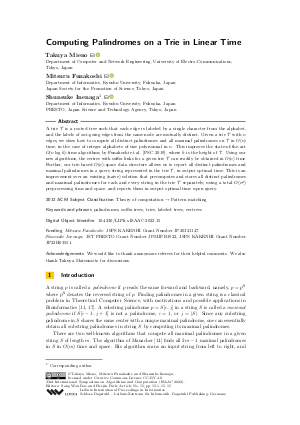@InProceedings{mieno_et_al:LIPIcs.ISAAC.2022.15,
author = {Mieno, Takuya and Funakoshi, Mitsuru and Inenaga, Shunsuke},
title = {{Computing Palindromes on a Trie in Linear Time}},
booktitle = {33rd International Symposium on Algorithms and Computation (ISAAC 2022)},
pages = {15:1--15:15},
series = {Leibniz International Proceedings in Informatics (LIPIcs)},
ISBN = {978-3-95977-258-7},
ISSN = {1868-8969},
year = {2022},
volume = {248},
editor = {Bae, Sang Won and Park, Heejin},
publisher = {Schloss Dagstuhl -- Leibniz-Zentrum f{\"u}r Informatik},
address = {Dagstuhl, Germany},
URL = {https://drops-dev.dagstuhl.de/entities/document/10.4230/LIPIcs.ISAAC.2022.15},
URN = {urn:nbn:de:0030-drops-173006},
doi = {10.4230/LIPIcs.ISAAC.2022.15},
annote = {Keywords: palindromes, suffix trees, tries, labeled trees, eertrees}
}

 Creative Commons Attribution 4.0 International license
Creative Commons Attribution 4.0 International license

